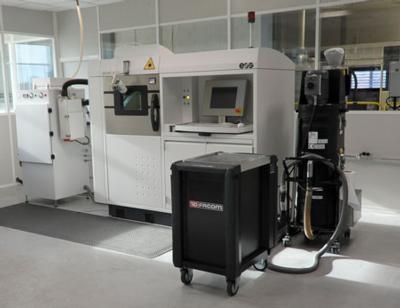Fri, Jan 16, 2015
Fuel Injector Nozzles Being Made Using Selective Laser Melting Techniques
Helicopter engine manufacturer Turbomeca is setting up new manufacturing capability at its facility in Bordes (France). After years of maturation and prototype testing, Turbomeca has entered serial production of parts using the latest additive manufacturing, or 3D printing process. Bordes facility is one of the first of its kind to serial produce additive components for aerospace propulsion industry in France.

Arrano test and production engines will feature fuel injector nozzles made using Selective Laser Melting (SLM) techniques. This leading-edge manufacturing process will also be used to manufacture Ardiden 3 combustor swirlers. These engines are Turbomeca’s latest models and amongst the most advanced turboshafts ever designed.
Additive manufacturing produces parts to a three-dimensional CAD (computer-aided design) model. Unlike traditional manufacturing processes (forging and machining) which are based on material removal, additive manufacturing builds layers, each between 20 and 100-micrometers thick, of fine metal powder to produce complex-shape parts. In the case of SLM, a computer-controlled laser shoots pinpoint beams onto a bed of nickel-based super-alloy powder, to melt the metal in the desired areas.

Additive Manufacturing also simplifies the manufacturing process. A traditional fuel-injector nozzle is made up from dozens different pieces. Arrano component is made from one single piece of material and features advanced injection and cooling functions. One SLM machine is already in service, and qualified for mass production, with others to be integrated over the coming years.
Additive manufacturing is part of Turbomeca’s ambitious “Future Line” program designed to improve all its manufacturing capabilities. By introducing new, high-end machine tools and new processes like additive manufacturing and HVOF (High Velocity Oxy-Fuel) coatings, Turbomeca will significantly improve its compressor and turbine blade manufacturing capabilities at Bordes.
(Images provided by Turbomeca)
More News
With Testing Soon Complete, Launch Preparations Begin in Earnest Sierra Space's Dream Chaser has been put through the wringer at NASA's Glenn Armstrong Test Facility in Ohio, but w>[...]
Takeoff Roll The process whereby an aircraft is aligned with the runway centerline and the aircraft is moving with the intent to take off. For helicopters, this pertains to the act>[...]
“We’re proud of the hard work that went into receiving this validation, and it will be a welcome relief to our customers in the European Union. We couldn’t be mor>[...]
"Aircraft Spruce is pleased to announce the acquisition of the parts distribution operations of Wag-Aero. Wag-Aero was founded in the 1960’s by Dick and Bobbie Wagner in the >[...]
IDENT Feature The special feature in the Air Traffic Control Radar Beacon System (ATCRBS) equipment. It is used to immediately distinguish one displayed beacon target from other be>[...]
 Sierra Space Repositions Dream Chaser for First Mission
Sierra Space Repositions Dream Chaser for First Mission ANN's Daily Aero-Term (05.10.24): Takeoff Roll
ANN's Daily Aero-Term (05.10.24): Takeoff Roll Aero-News: Quote of the Day (05.10.24)
Aero-News: Quote of the Day (05.10.24) Aero-News: Quote of the Day (05.11.24)
Aero-News: Quote of the Day (05.11.24) ANN's Daily Aero-Term (05.11.24): IDENT Feature
ANN's Daily Aero-Term (05.11.24): IDENT Feature




